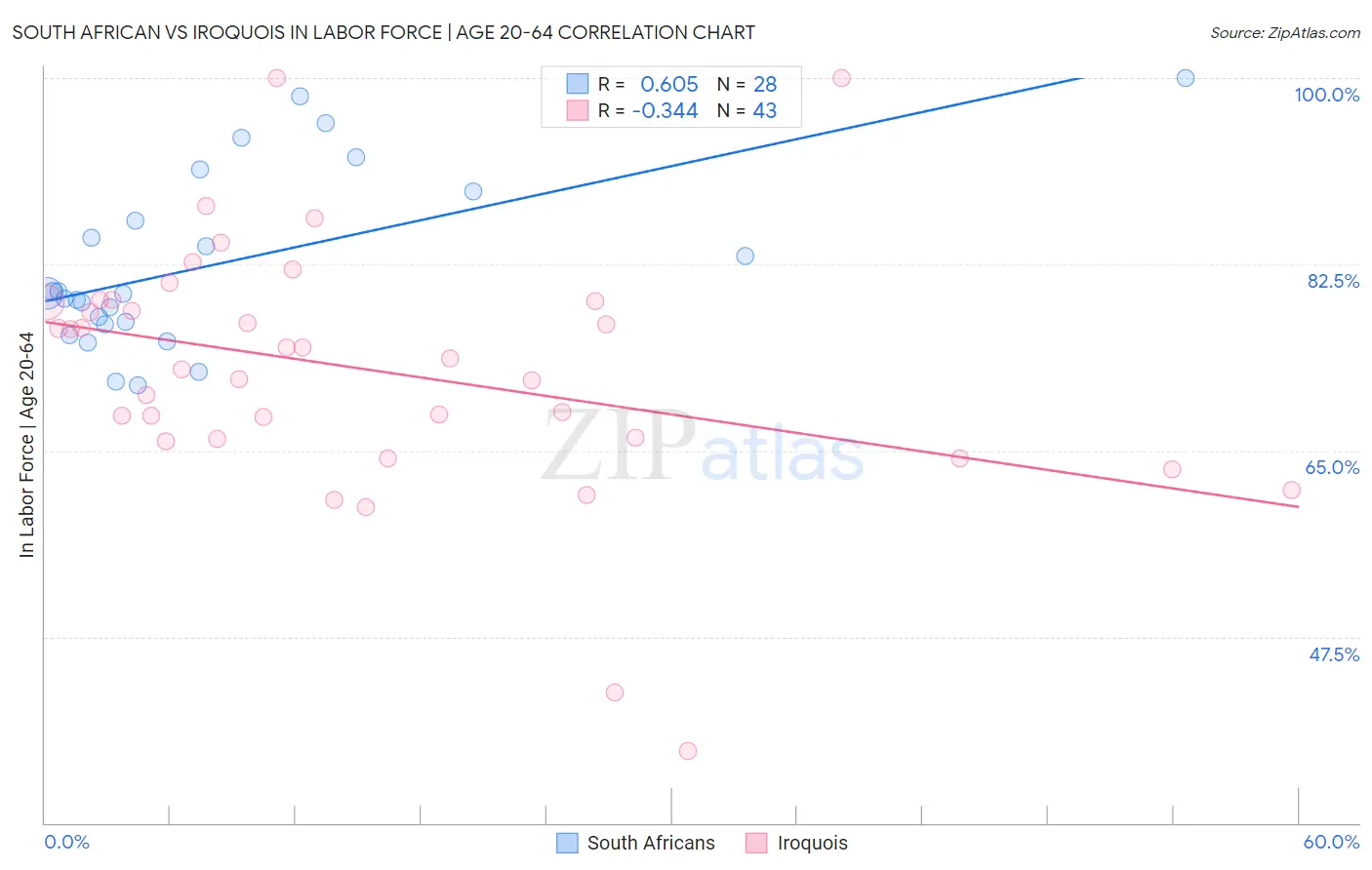South African vs Iroquois In Labor Force | Age 20-64
COMPARE
South African
Iroquois
In Labor Force | Age 20-64
In Labor Force | Age 20-64 Comparison
South Africans
Iroquois
79.7%
IN LABOR FORCE | AGE 20-64
66.2/ 100
METRIC RATING
161st/ 347
METRIC RANK
77.5%
IN LABOR FORCE | AGE 20-64
0.0/ 100
METRIC RATING
302nd/ 347
METRIC RANK
South African vs Iroquois In Labor Force | Age 20-64 Correlation Chart
The statistical analysis conducted on geographies consisting of 182,600,467 people shows a significant positive correlation between the proportion of South Africans and labor force participation rate among population between the ages 20 and 64 in the United States with a correlation coefficient (R) of 0.605 and weighted average of 79.7%. Similarly, the statistical analysis conducted on geographies consisting of 207,293,239 people shows a mild negative correlation between the proportion of Iroquois and labor force participation rate among population between the ages 20 and 64 in the United States with a correlation coefficient (R) of -0.344 and weighted average of 77.5%, a difference of 2.8%.

In Labor Force | Age 20-64 Correlation Summary
| Measurement | South African | Iroquois |
| Minimum | 71.1% | 36.8% |
| Maximum | 100.0% | 100.0% |
| Range | 28.9% | 63.2% |
| Mean | 82.4% | 72.6% |
| Median | 79.7% | 73.7% |
| Interquartile 25% (IQ1) | 77.0% | 66.1% |
| Interquartile 75% (IQ3) | 88.0% | 79.0% |
| Interquartile Range (IQR) | 11.0% | 12.9% |
| Standard Deviation (Sample) | 8.1% | 11.8% |
| Standard Deviation (Population) | 8.0% | 11.7% |
Similar Demographics by In Labor Force | Age 20-64
Demographics Similar to South Africans by In Labor Force | Age 20-64
In terms of in labor force | age 20-64, the demographic groups most similar to South Africans are Immigrants from Cuba (79.7%, a difference of 0.0%), Moroccan (79.7%, a difference of 0.0%), Austrian (79.7%, a difference of 0.010%), German (79.7%, a difference of 0.010%), and Immigrants from Costa Rica (79.7%, a difference of 0.010%).
| Demographics | Rating | Rank | In Labor Force | Age 20-64 |
| New Zealanders | 69.4 /100 | #154 | Good 79.7% |
| Immigrants | South Africa | 69.2 /100 | #155 | Good 79.7% |
| Senegalese | 69.1 /100 | #156 | Good 79.7% |
| Immigrants | China | 69.1 /100 | #157 | Good 79.7% |
| Austrians | 67.6 /100 | #158 | Good 79.7% |
| Immigrants | Cuba | 66.7 /100 | #159 | Good 79.7% |
| Moroccans | 66.7 /100 | #160 | Good 79.7% |
| South Africans | 66.2 /100 | #161 | Good 79.7% |
| Germans | 65.2 /100 | #162 | Good 79.7% |
| Immigrants | Costa Rica | 64.6 /100 | #163 | Good 79.7% |
| Immigrants | Burma/Myanmar | 64.4 /100 | #164 | Good 79.7% |
| Nigerians | 64.0 /100 | #165 | Good 79.7% |
| Okinawans | 62.7 /100 | #166 | Good 79.6% |
| Immigrants | Iraq | 62.0 /100 | #167 | Good 79.6% |
| Immigrants | Indonesia | 61.8 /100 | #168 | Good 79.6% |
Demographics Similar to Iroquois by In Labor Force | Age 20-64
In terms of in labor force | age 20-64, the demographic groups most similar to Iroquois are Nepalese (77.5%, a difference of 0.050%), Spanish American Indian (77.6%, a difference of 0.090%), Hispanic or Latino (77.6%, a difference of 0.16%), Dominican (77.7%, a difference of 0.22%), and Cree (77.7%, a difference of 0.22%).
| Demographics | Rating | Rank | In Labor Force | Age 20-64 |
| Immigrants | Grenada | 0.0 /100 | #295 | Tragic 77.7% |
| Immigrants | Dominican Republic | 0.0 /100 | #296 | Tragic 77.7% |
| Dominicans | 0.0 /100 | #297 | Tragic 77.7% |
| Cree | 0.0 /100 | #298 | Tragic 77.7% |
| Hispanics or Latinos | 0.0 /100 | #299 | Tragic 77.6% |
| Spanish American Indians | 0.0 /100 | #300 | Tragic 77.6% |
| Nepalese | 0.0 /100 | #301 | Tragic 77.5% |
| Iroquois | 0.0 /100 | #302 | Tragic 77.5% |
| Chippewa | 0.0 /100 | #303 | Tragic 77.3% |
| Immigrants | Mexico | 0.0 /100 | #304 | Tragic 77.3% |
| Mexicans | 0.0 /100 | #305 | Tragic 77.2% |
| Potawatomi | 0.0 /100 | #306 | Tragic 77.2% |
| Central American Indians | 0.0 /100 | #307 | Tragic 77.1% |
| Alaska Natives | 0.0 /100 | #308 | Tragic 77.0% |
| Americans | 0.0 /100 | #309 | Tragic 77.0% |